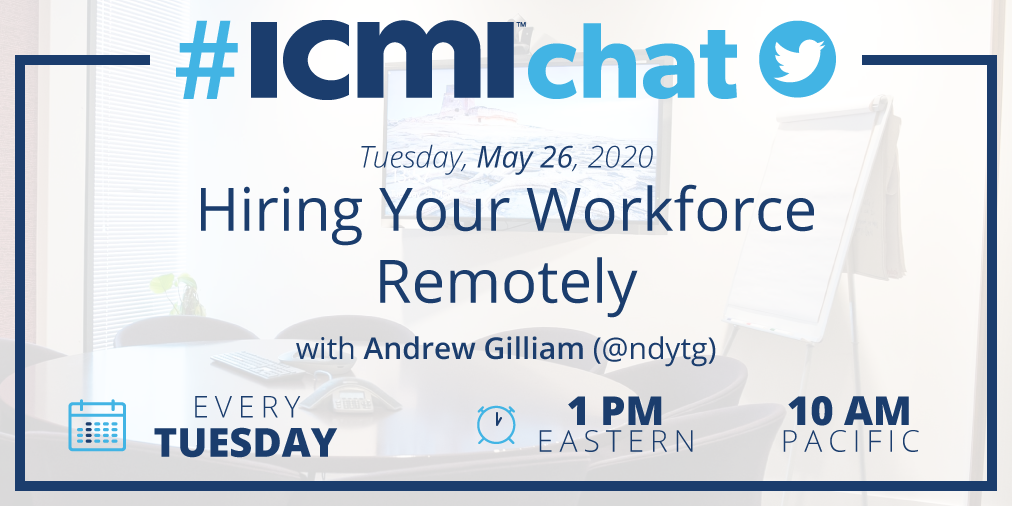By
The Editors
|
Date Published: May 21, 2020 - Last Updated September 08, 2020
|
Comments

When it comes to contact centers, people are the first ingredient. Having the right number of agents available at any given time is tricky. This is where the practice of workforce management (WFM) steps in. Workforce management encapsulates demand forecasting, resource scheduling, and time management to achieve desired levels of service while optimizing labor costs.
Join us on Tuesdays at 1 p.m. Eastern, 10 a.m. Pacific to weigh in on the contact center industry's most pressing challenges. Next week, we explore "Hiring Your Workforce Remotely." A question preview follows this article.
This week, #ICMIchat unpacks the importance of workforce management and its impact on the agent and customer experience. Our seasoned contact center leaders also describe their tips, tricks, and WFM best practices. Special thank you to Jeremy Watkin for guest-hosting this #ICMIchat.
Right Team. Right Time.
Workforce management is much more than employee scheduling. By analyzing how employees spend their time, workforce managers are able to assess how many people a contact center really needs accurately. Using a combination of historical data, industry knowledge, and intuition, workforce managers anticipate customer demand to achieve a specific level of service at a particular time.
WFM's purpose in the contact center:
- Call volume forecasting & scheduling
- Business continuity planning
- Day-of queue management
- Managing time-off requests
In short: Having the right # of employees with the right skill set, scheduled at the right time.
To maximize benefit, modern workforce management WFM in contact centers should include AI tools, automated workflows, and machine learning. Reliable forecasting is imperative to meet service levels & achieve good CSAT. Find tech that meets needs. It likely exists!
The purpose of WFM is to be the ruler of time and money. Actually creating demand forecasts, develop and manage schedules, sometimes monitor quantifiable agent behaviors, and do it all in concert with fiduciary and human responsibility.
Scheduling for Humans
When executing the practices of workforce management, it's crucial to remember that we're scheduling human beings, not inanimate resources. Both the businesses and agents have needs; finding balance and alignment between the two is the name of the game. If schedules don't work for agents, they'll become dissatisfied with their jobs and leave the organization. Replacing agents is a costly endeavor.
This may not be common philosophy - but I believe we need to work extremely hard to get schedules right for the business and the team members. Schedules are a significant factor in employee satisfaction, imo.
Break the "babysitting" mentality. Help agents to do there best work by setting them up for success! Almost none can provide exceptional service when they are staring a 200 ticket backlog in the face.
Retention or Attrition. Your Choice.
Work is a big part of our employees' lives. As such, their schedules have tremendous impacts on their time outside of work. Service targets and scheduling also have a significant effect on the structure of agents' work, by determining how busy they'll be during the day, whether there's time for training and development, and how often they can take a break to recover from the emotional fatigue that comes with customer service work. These choices set the tone of your company's labor relations and determine whether agents stay or go.
The WFM tasks that agents are most concerned with are: a) Shift scheduling & trading, b) Approving time-off requests. Both employee churn and engagement are impacted by decisions made on the WFM side of the business.
WFM is where a critical decision is made... Are we here to such as much as we can out of people for the lowest cost? Or are we going to build them up and make them long-term assets?
Sticking To The Plan
Workforce management only works when everyone is on the same page doing their part. This is where schedule adherence comes in, the metric of how often agents stick to their assigned schedule. As individual contributors working in parallel with so many others, it's not always clear to agents how they personally make a difference. This can lead to carelessness and low adherence. It's essential for supervisors and coaches to connect agents' behaviors with the impact they have on their peers and the business.
I also do an exercise where I ask reps to “estimate” the time in each shrinkage category I give them. When I ask them to estimate the adherence bucket, we talk about what goes into that adherence buffer, and how others outside the contact center might interpret it.
If you don’t tell agents how actions and attendance matter, they won't understand how they affect service level and profits. Show them they impact the bottom line, teach them their contributions matter, and you empower them to positively impact schedule adherence.
Controversial topic! 1st, adherence as % should be used directionally. Helps you identify outliers. Agents should focus on what they CAN control and not worry about delays caused by serving a customer.
Working the volume of time and specific specific times to work. Adherence programs fail when the goal doesn't consider AHT length or # of times logging in and out, entering exceptions after the fact, and using draconian monitoring to force bad behaviors.
Minding Adherence
It's not always easy to keep employees on schedule and on task. Minds wander. Distractions appear. Sometimes things just come up out of nowhere. Contact center coaches and supervisors can become nags if we're not careful. Consider your approach to keeping agents' on the line; playing whack-a-agent isn't recommended.
Monitor for aberrations - call routing issues, outages, agents who disappear (poof!). Make sure agents know how to get help when they need help. STOP playing whack-an-agent by bothering them during calls! Use data to support behavioral coaching in 1:1 sessions.
I favor tools that allow reps to self-manage and provide useful insight and alerts when they move out of reasonable adherence thresholds. No one likes the incessant manager pings but give the tools to manage myself.
Personally, I am not a fan of 'managing' adherence real-time, but most software used by WFM includes a component that allows for just that. Particularly for remote agents, a quick check-in via instant message after e.g. a significant idle period can do the trick.
Data Matters
Workforce management leverages what we know about the past and our expectations for the future to inform the actions we take today. Workforce managers need accurate, detailed data in order to forecast demand and predict future levels of service. Without data, your guess is as good as mine.
Not enough characters. Simply, how many contacts to expect (this is challenging in some environments), average time to handle a contact (understand AHT by day/interval, and impact of accurately forecasting it), how many people this means you need, factor shrinkage.
There are 6 basic ingredients - call volume and AHT projections, shrinkage plans, occupancy goals, seasonality, and daily arrival patterns.
Closing the Loop
After implementing a workforce management strategy, it's crucial to analyze how accurately goals were met and learn from past performance. Workforce managers must consider service levels, shrinkage, absenteeism, agent satisfaction, and more to make better predictions in the future.
Although not often seen as the most important WFM metric to track, employee satisfaction can’t be discounted. Happy agents show up, work hard, contribute in meaningful ways and lead to better metrics in all other categories.
I'll talk about just 1 today. When we talk "forecast accuracy" what forecast are you comparing against? If you update forecast daily and then compare against that...like fish in a barrel. You need to compare against an original that gave time for planning.
Driving Customer Experience
Workforce management has a tremendous impact on customer experience because of how greatly agents are impacted by it. Failures to take care of agents as people give them an uphill battle for maintaining the positive attitudes we want. Furthermore, workforce management directly impacts service levels and delays that customers experience first hand.
Navigating the IVR, incorrect call routing and long waits are huge dissatifiers and typically fall under the WFM umbrella. Time off-queue for training, coaching, and customer-impacting offline tasks is equally important, as it impacts the Customer Experience.
Good workforce management is linked to good customer experience CX. WFM allows accurate call routing. Knowing individual skill sets for agents and which agents are adept at taking the most challenging calls is important to service level outcomes and CSAT.
#ICMIchat May 26, 2020
Hiring Your Workforce Remotely
Last week's #ICMIchat helped you learn how to schedule your team, but how do you build a team in the age of social distancing? Remote hiring brings on new challenges and opportunities. Join us on Tuesday at 1 p.m. Eastern/10 a.m. Pacific to find out how to grow your remote workforce.

Q1: Does social distancing make it easier or more difficult to hire great talent?
Q2: How will remote interviews and selection affect job applicants? Will they have unique challenges?
Q3: Should hiring managers prepare to do anything differently when hiring remote employees?
Q4: Trust is vital when it comes to a remote workforce. How do hiring managers know who they can trust?
Q5: Do new hires ever get frustrated or leave jobs because the work wasn't what they expected? Is this problem amplified or minimized in remote environments, and how can we prevent it?
Q6: How can leaders communicate/demonstrate their organization's culture when it's not possible to show applicants in person?
Q7: Will social distancing and remote work environments affect attrition and turnover? How?
Q8: If you could change anything about the recruitment, selection, and hiring process right now, what would you do?